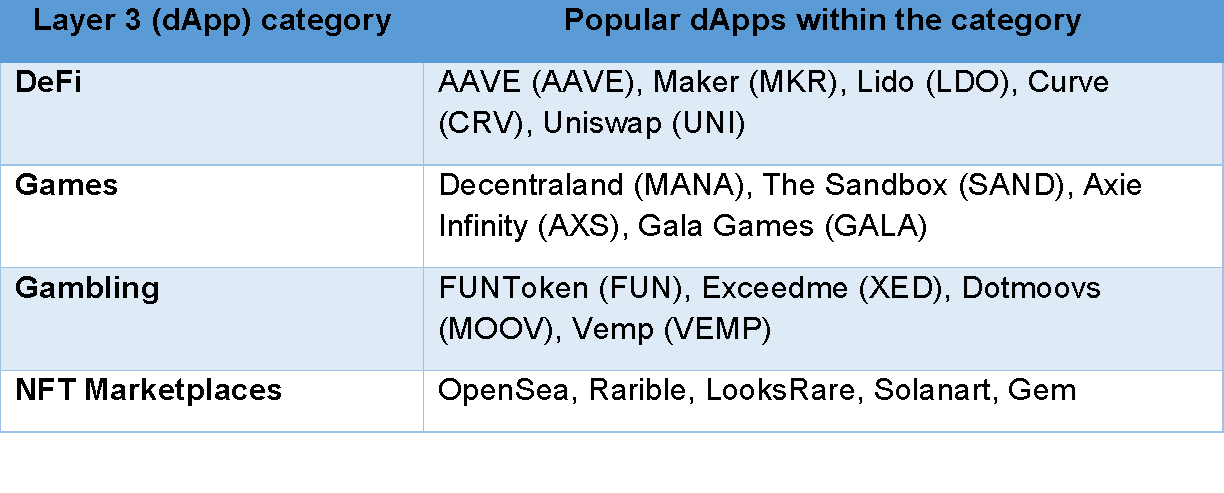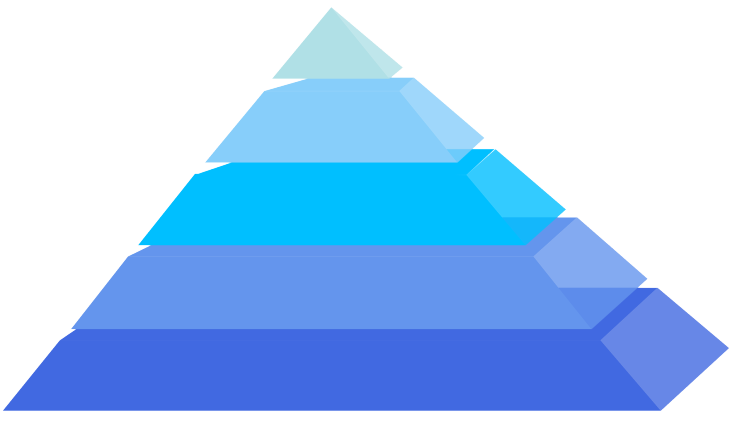The overall architecture of blockchain networks and ecosystems is often represented by three main layers, referred to as layer 1, layer 2, and layer 3.While layer 1 denotes the underlying blockchain platform, layers 2 and 3 are made up of a variety of solutions and applications used to enable new functionality or services on the chain.
What Are the Layers in Blockchain?
Blockchain networks originally had no separation into layers. When Bitcoin (BTC) was launched in 2009, its main functionality was to enable crypto asset transfers and storage, with all the operations happening on-chain.
However, soon afterwards, blockchain solutions that aimed to extend or improve Bitcoin’s functionality emerged. This was followed by the arrival of Ethereum (ETH) and the rich ecosystem of decentralized apps (dApps) and services brought about by this blockchain.
The increasing variety of blockchain-based apps, services, and functional solutions has led to the development of a layer-based view of blockchain’s overall architecture.
Within the layer-based view, layer 1 refers to the actual blockchain network. Examples of layer 1 blockchains include Ethereum, Bitcoin, Solana (SOL), Cardano (ADA), Bitcoin Cash (BCH), and many others. All these platforms have their own networks with the usual elements of a blockchain - a consensus mechanism, transaction validation procedures, and cryptographic security setup.
Layer 2 in blockchain refers to solutions that are designed to extend or improve some functionality of the layer 1 chain they are based on. Typically, layer 2 solutions are designed to make blockchain transactions cheaper and faster.
Layer 3 refers to dApps hosted on layer 1 chains that offer a variety of services and applications, such as decentralized finance (DeFi), gaming, entertainment, peer-to-peer (P2P) payments, and NFT marketplaces.
Layer 2 Solutions
Layer 2 solutions operate on top of or by using the underlying layer 1 blockchain. They typically handle some of the transaction processing off-chain and post the finalised results to layer 1. The most common layer 2 solution types include:
ZK rollups post processed transaction batches to layer 1 with a cryptographic proof of validity. They process a transaction using the minimum required information, without having access to all the sensitive details of each transaction. Due to this feature, they are called “zero-knowledge”.
Unlike ZK rollups, optimistic rollups post processed transactions to the underlying chain without proof of validity. Instead, there is a waiting period during which the posted transaction batch may be challenged by network validators using proof of fraud. During the waiting period, if no proof of fraud is presented by a validator, the transaction batch is written to the layer 1 chain.
Rollups have become the most common layer 2 solution and have superseded plasmas and channels in terms of popularity and efficiency. Popular ZK rollup protocols include ZK Sync and Loopring. The most commonly used optimistic rollups are Optimism, Arbitrum, and Boba Network.
Layer 3 Solutions
Layer 3 is made up of various dApps running on smart-contract capable chains, such as Ethereum, Solana, Cardano, Tron, and Avalanche, among others. Bitcoin has no such solutions due to the lack of smart contract capabilities.
The key goal of layer 2 is to make blockchains more scalable and cheaper to transact on. On the other hand, the key goal of layer 3 is to provide complete applications for a variety of use cases, such as DeFi, games, NFT marketplaces, online casinos, and more.
The image below shows the most common layer 3 app categories along with popular dApps within each category.
What Are the Layers in Blockchain?
Blockchain networks originally had no separation into layers. When Bitcoin (BTC) was launched in 2009, its main functionality was to enable crypto asset transfers and storage, with all the operations happening on-chain.
However, soon afterwards, blockchain solutions that aimed to extend or improve Bitcoin’s functionality emerged. This was followed by the arrival of Ethereum (ETH) and the rich ecosystem of decentralized apps (dApps) and services brought about by this blockchain.
The increasing variety of blockchain-based apps, services, and functional solutions has led to the development of a layer-based view of blockchain’s overall architecture.
Within the layer-based view, layer 1 refers to the actual blockchain network. Examples of layer 1 blockchains include Ethereum, Bitcoin, Solana (SOL), Cardano (ADA), Bitcoin Cash (BCH), and many others. All these platforms have their own networks with the usual elements of a blockchain - a consensus mechanism, transaction validation procedures, and cryptographic security setup.
Layer 2 in blockchain refers to solutions that are designed to extend or improve some functionality of the layer 1 chain they are based on. Typically, layer 2 solutions are designed to make blockchain transactions cheaper and faster.
Layer 3 refers to dApps hosted on layer 1 chains that offer a variety of services and applications, such as decentralized finance (DeFi), gaming, entertainment, peer-to-peer (P2P) payments, and NFT marketplaces.
Layer 2 Solutions
Layer 2 solutions operate on top of or by using the underlying layer 1 blockchain. They typically handle some of the transaction processing off-chain and post the finalised results to layer 1. The most common layer 2 solution types include:
- Channels. These are protocols that help establish a direct communication and payment channel between two or more parties on the blockchain. Their key goal is to help provide improved scalability and transaction efficiency by utilising the channel. One of the earliest and most popular channel solutions for Bitcoin is the Lightning Network. Popular channel solutions for Ethereum include Connext Network and Kchannels.
- Plasmas. These protocols create sidechains attached to the main layer 1 chain and use these sidechains for the bulk of transaction processing. Unlike channels, plasma sidechains have their own consensus and security mechanisms that are separate from those of the main layer 1 chain. Plasma solutions are typically used to solve the cost and scalability inefficiencies of Ethereum. Popular plasma platforms include Loom Network and OMG Network.
- Rollups. These solutions process transactions off-chain in batches and then post the processed batches to the underlying layer 1 chain. Rollups come in two main varieties – optimistic rollups and zero-knowledge (ZK) rollups.
ZK rollups post processed transaction batches to layer 1 with a cryptographic proof of validity. They process a transaction using the minimum required information, without having access to all the sensitive details of each transaction. Due to this feature, they are called “zero-knowledge”.
Unlike ZK rollups, optimistic rollups post processed transactions to the underlying chain without proof of validity. Instead, there is a waiting period during which the posted transaction batch may be challenged by network validators using proof of fraud. During the waiting period, if no proof of fraud is presented by a validator, the transaction batch is written to the layer 1 chain.
Rollups have become the most common layer 2 solution and have superseded plasmas and channels in terms of popularity and efficiency. Popular ZK rollup protocols include ZK Sync and Loopring. The most commonly used optimistic rollups are Optimism, Arbitrum, and Boba Network.
Layer 3 Solutions
Layer 3 is made up of various dApps running on smart-contract capable chains, such as Ethereum, Solana, Cardano, Tron, and Avalanche, among others. Bitcoin has no such solutions due to the lack of smart contract capabilities.
The key goal of layer 2 is to make blockchains more scalable and cheaper to transact on. On the other hand, the key goal of layer 3 is to provide complete applications for a variety of use cases, such as DeFi, games, NFT marketplaces, online casinos, and more.
The image below shows the most common layer 3 app categories along with popular dApps within each category.


